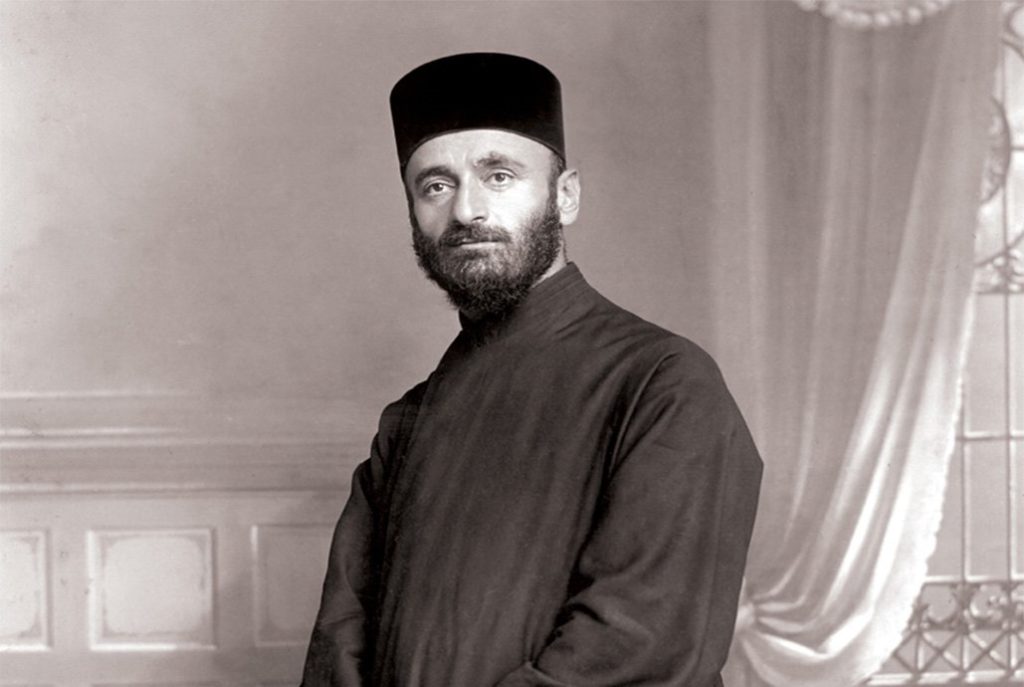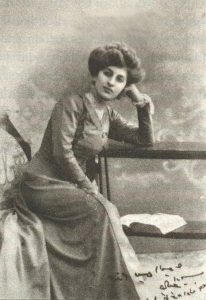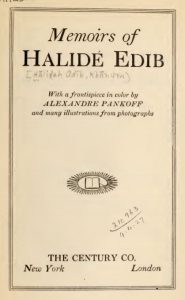Special to the Armenian Weekly
I first heard the name of Halide Edib Ad?var in Turkey, in 1997, while on a tour, when the tour guide referred to the Genocide of Armenians as “the dark days of our country’s history” and stated that she had read Halide Edib’s writings. I then read a passage in a newspaper, on a meeting of Edib with Komitas [Gomidas] after the latter’s return from exile, in 1915. I kept this article and read it again when writing a book on Komitas’s mental state (see
Komitas: Victim of the Great Crime, 2014).

Komitas (Photo: Komitas Museum-Institute)
I subsequently bought Edib’s
Memoirs of Halide Edib»(2005), in which Edib writes not only about her encounter with Komitas but also about becoming the principal of the orphanage in Antoura (then Syria, now Lebanon) on the invitation of Cemal/Jemal Pasha; I knew about Antoura orphanage, having read my teacher’s, Karnig Panian’s memoirs of his childhood—from his native Gurin to the orphanage and more. Because I explore the psychological consequences of the genocide, both subjects interested me: Komitas’s mental state and happenings at the Antoura orphanage.
Halide Edib was the daughter of Sultan Abdul Hamid’s secretary, Edib Bey. She attended a Christian Greek school and was raised appreciating tolerance, according to the introduction to her Memoirs. Halide Edib was a respected feminist and nationalist Turkish writer and novelist; in the introduction to her memoirs, H. Dak states, “Although not the first, Halide Edib (1882-1964) is the most prolific Ottoman-Turkish woman writers, with 21 novels, four short story collections, two dramas, four scholarly works and a two-volume autobiography.”
Reading her memoirs, the discerning reader notices the author’s tendentious, biased representations of Komitas, and Armenians generally, combined with a real appreciation of his art and work.
We learn, for example, about Turk Ocak/Ojak, where Komitas was invited to perform a few weeks before his imprisonment. Edib writes, “It is in that hall that I came to know Goumitas [sic]
Vartabet, the Armenian priest, musician, and composer. He was one of those musicians, actors, and lecturers of fame whom the Ojak invited to address its weekly audiences.
“Goumitas had become very famous with the Anatolian songs and the music of the old Gregorian chants which he had collected during years of patient labor in Constantinople and Anatolia. He had trained a choir of the Armenian youth and was considered a great leader among the Armenians.”
Edib continues, “As he appeared in the long black coat of the priest, his dark face as na?ve as any simple Anatolian’s, and his eyes full of the pathos and longing which his voice expressed in its pure strong notes, I felt him an embodiment of Anatolian folk-lore and music.
“The airs were the ones I had often heard our servants from Kemah and Erzeroum sing. He had simply turned the words into Armenian. But I did not pay any attention to the language; I only felt the inner significance of that tender and desolate melody from the lonely wastes of Anatolia.”
Edib further writes, “Goumitas came from Kutahia and was of very poor parents. They knew no Armenian, and Goumitas learned it only in later life. His parents were probably of Turkish descent, from the Turkis who had joined the Gregorian church. The Byzantine rulers had called in Turkish tribes to form a barrier against the Saracenic invasions, and though these were mostly put along the southern frontiers, some might have moved elsewhere…. He was an Armenian nationalist whether his origin was Turkish or Armenian, but in temperament and heart he was a real Anatolian Turk if unconsciously….

Halide Edib Ad?var
“As a man and as an artist Goumitas was of a quality one rarely meets. His asceticism, the pure and beautiful simplicity with which he taught the Armenians, might well have been imitated by other nationalists. His way of expressing Anatolia both in song and in feeling was profoundly worth hearing.”
Edib is correct that Komitas knew Turkish well; however, she is incorrect in stating that Komitas had collected his music in Constantinople. By the time Komitas moved to Constantinople, in 1910, he had already collected peasants’ songs in Eastern and Western Armenia as well as Anatolia.
Moreover, in his autobiography, dated June 24, 1908, Komitas states clearly, “I was born on September 26
[1], 1869 in Asia Minor, in the city of Godin or Kutahya. They christened me on the third day and called me Soghomon. My father, Kevork Soghomonian, was a native of Kutahya, while my mother, Takouhi Hovhannisian, a native of Brusa. Both were Armenian. Both families were known for their singing voices…. Songs composed by my mother and father in the Turkish [
Dajig] language, a few of which I had already written down in 1893, in my native town are still sung with great admiration by the elders there….”
Kutahya Armenians spoke Turkish. Takouhi composed songs in Turkish. Kutahya Armenians, like many other Armenians in Turkey, were severely punished for speaking Armenian. Komitas’s familiarity with the Turkish language and the fact that he re-arranged the songs his mother sang in Turkish do not make him a Turk. He was an Armenian whose roots went back to the Tsghna Village in Koghtn county, Nakhichevan, formerly Armenian, now in Azerbaijan.

Memoirs of Halide Edib was first published in English in 1926 (Photo: The Century Co.)
Edib continues, “The acquaintance that began that day continued, Goumitas often coming to my house to sing. He continued to come even after the Armenians and Turks were massacring each other. We both silently suffered under the condition of things, but neither of us mentioned it. Mehemmed Emin and Yahia Kemal Beys, both great poets who had always taken a humanitarian view of nationalism, were interested in his personality and came to hear him. Youssouf Akchura also came, prompted by his love of music, but he declared that Goumitas had done a great harm to the Turk by stealing his popular culture in the form of music and songs.”
Those views were not unique to Edib and Akchura.
In March of 1915, at the Ojak, at the conclusion of Komitas’s performance, the audience composed of Turkish and non-Turkish music-loving society had sighed deeply; some had shouted, “May God protect him from the evil eye.” [Karakashian, p. 93]. The speaker of the day had stressed that the child of Anatolia, the Armenian priest, through his dedication and hard work, had given wings to Armenian music, presenting the folk songs he collected as Armenian national heritage, whereas Turkish clergy had not done that…
Komitas continued his work until his imprisonment, on April 23, 1915. Referring to an encounter after his exile in 1915, Edib writes:
Goumitas one day sang an Ave Maria in Armenian which belonged to the sixth century, a thing of rare mystical beauty; and the utter ecstasy and religious emotion of the air so fascinated me that I asked him if he had set any of the Psalms to music.
“Yes,” he said, “the one-hundred-and-first.”
“Are you too tired to sing it?” I asked.
He had thrown himself into the low chair near the piano, and his face was white and full of strange lines of pain.
He began singing without moving from the chair. As he began to sing I felt that the air had none of the sacred and humble beauty of the Ave Maria… It awed me and made me feel strange. I instinctively took the Bible from the bookcase near me and found the last stanzas of Psalm 1010, “I will early destroy all the wicked of the land: that I may cut off all wicked doers from the city of the Lord.”
It was the cry of the hatred and vengeance of his soul for my people…. In 1915 the Ojak generously used its influence to have him spared from deportation, but in 1916 he had a serious disturbance in his mind, which gave way under the strain of those horrible times. Dr. Adnan begged Talaat Pasha to allow him to go to Paris for a cure, and this was accorded to him. He is still in an asylum.
My book,
Komitas: Victim of the Great Crime, of course presents the events differently, through research.
***
References
Edib, H. A. (2005/1926). Memoirs of Halide Edib. A. Pankoff (Ed.).
Karakashian, M. (2014). Medz Yegherni Zoheh. Yerevan: Dall.
Karakashian, M. (2014). Komitas: Victim of the Great Crime. Yerevan: Zangak.
Komitas Vartabed Gudinatsi (Michin Asya, Brusayi Marz), (Hounis 24),
Inknagensakroutioun.
Notes
[1] »»»»»»»»»»»» The Julian and Gregorian calendars have a 12 days difference from 1800 to 1900, and 13 days after 1900.
Special to the Armenian Weekly I first heard the name of Halide Edib Ad?var in Turkey, in 1997, while on a tour, when the tour guide referred to the Genocide of Armenians as “the dark days of our country’s history” and stated that she had read Halide Edib’s writings. I then read a passage in a newspaper, on a meeting of Edib with Komitas [Gomidas] after the latter’s return from exile, in 1915. I kept this article and read it again when writing a book on Komitas’s mental state (see Komitas: Victim of the Great Crime, 2014). Komitas (Photo: Komitas Museum-Institute) I subsequently bought Edib’s Memoirs of Halide Edib»(2005), in which Edib writes not only about her encounter with Komitas but also about becoming the principal of the orphanage in Antoura (then Syria, now Lebanon) on the invitation of Cemal/Jemal Pasha; I knew about Antoura orphanage, having read my teacher’s, Karnig Panian’s memoirs of his childhood—from his native Gurin to the orphanage and more. Because I explore the psychological consequences of the genocide, both subjects interested me: Komitas’s mental state and happenings at the Antoura orphanage. Halide Edib was the daughter of Sultan Abdul Hamid’s secretary, Edib Bey. She [...]
Special to the Armenian Weekly I first heard the name of Halide Edib Ad?var in Turkey, in 1997, while on a tour, when the tour guide referred to the Genocide of Armenians as “the dark days of our country’s history” and stated that she had read Halide Edib’s writings. I then read a passage in a newspaper, on a meeting of Edib with Komitas [Gomidas] after the latter’s return from exile, in 1915. I kept this article and read it again when writing a book on Komitas’s mental state (see Komitas: Victim of the Great Crime, 2014). Komitas (Photo: Komitas Museum-Institute) I subsequently bought Edib’s Memoirs of Halide Edib»(2005), in which Edib writes not only about her encounter with Komitas but also about becoming the principal of the orphanage in Antoura (then Syria, now Lebanon) on the invitation of Cemal/Jemal Pasha; I knew about Antoura orphanage, having read my teacher’s, Karnig Panian’s memoirs of his childhood—from his native Gurin to the orphanage and more. Because I explore the psychological consequences of the genocide, both subjects interested me: Komitas’s mental state and happenings at the Antoura orphanage. Halide Edib was the daughter of Sultan Abdul Hamid’s secretary, Edib Bey. She [...]
[img][/img]
More...